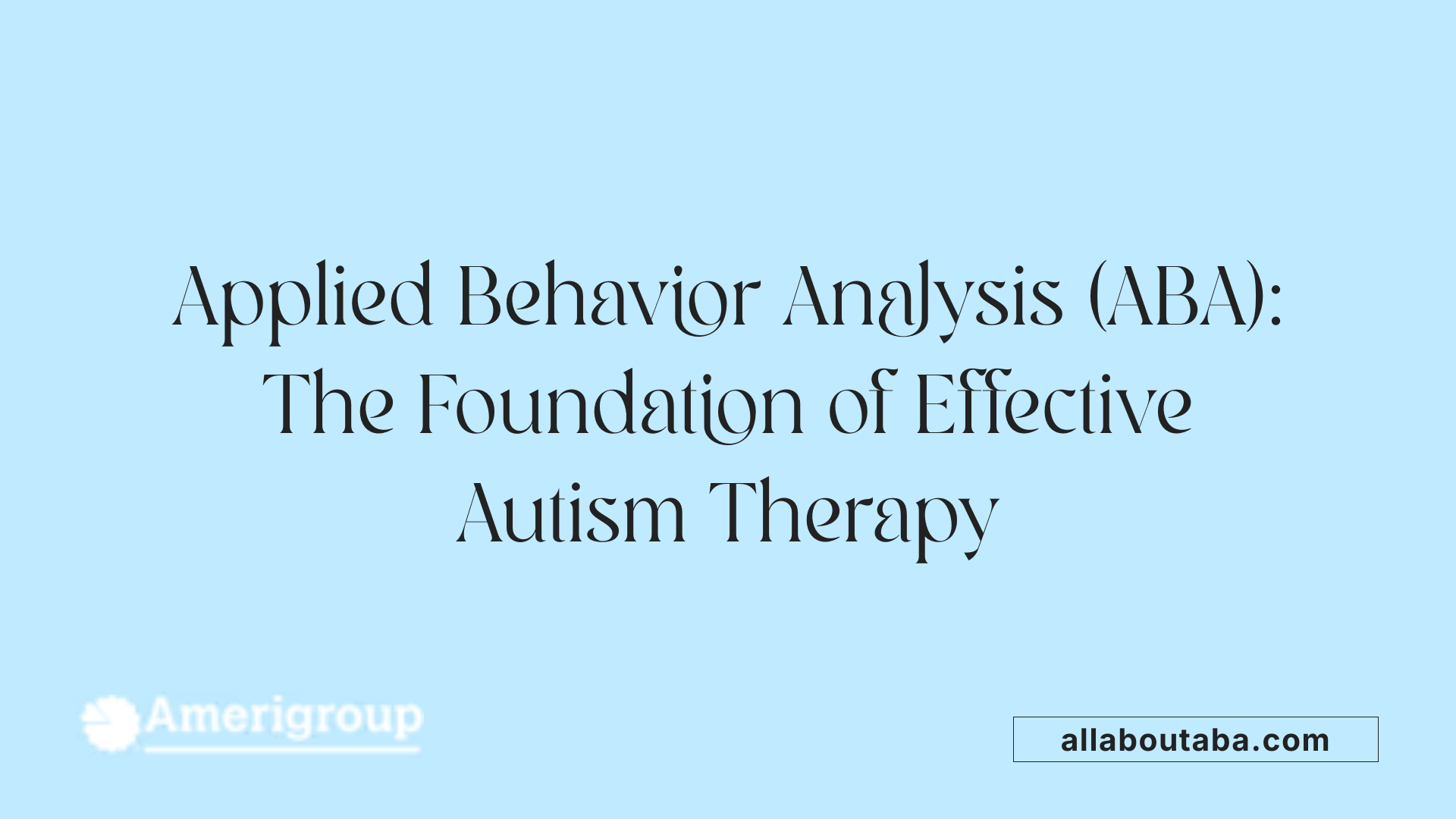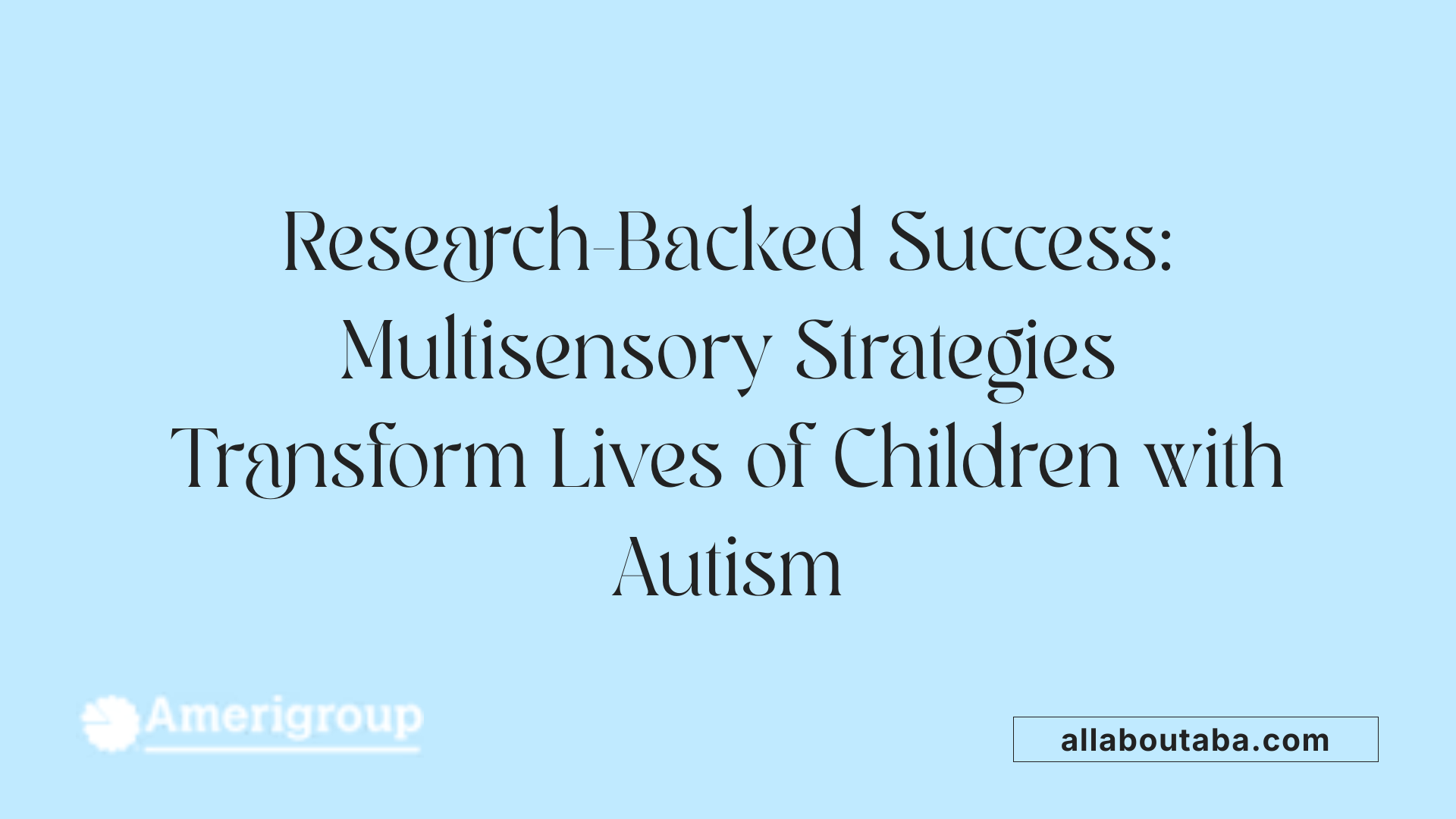Understanding the Landscape of Autism Therapy
Autism spectrum disorder (ASD) presents unique challenges in communication, social interaction, and behavior that demand tailored therapeutic approaches. Among the most effective evidence-based interventions is Applied Behavior Analysis (ABA), supported by trained professionals employing structured, data-driven methods to foster skill development and reduce problematic behaviors. Recent advances spotlight the role of multisensory learning—engaging vision, hearing, touch, smell, and taste—in autism education, providing new pathways for enhancing communication, social skills, and behavioral outcomes.
Defining Autism Therapy and Its Role in Enhancing Individual Potential

What is autism therapy and how does it help individuals with autism?
Autism therapy refers to a range of evidence-based methods designed to support individuals on the autism spectrum by addressing their unique strengths and challenges. The primary aim is to enhance communication, social skills, and behavioral adjustments, thereby promoting greater independence and quality of life.
Overview of autism therapy modalities
Therapies for autism span diverse approaches, including:
- Applied Behavior Analysis (ABA): Reinforces positive behaviors through structured interventions.
- Speech and Language Therapy: Focuses on improving verbal and non-verbal communication skills.
- Occupational Therapy: Aids daily living activities and sensory integration.
- Educational Programs (e.g., TEACCH): Employ structured routines and visual aids to support learning.
- Social Skills Training: Helps individuals navigate social interactions and build relationships.
Goals of therapy in improving communication, social and behavioral skills
Autism therapies aim to develop essential areas such as:
- Communication: Facilitating both expressive and receptive abilities.
- Social Interaction: Enhancing understanding of social cues and building connections.
- Behavioral Skills: Reducing undesirable behaviors and promoting adaptive responses.
By focusing on these areas, therapy helps individuals better engage with their environment and community.
Importance of early and personalized intervention
Early intervention is critical for maximum outcomes, given that children's brains are more adaptable at younger ages. Tailoring therapy plans to each child's specific needs and strengths ensures more effective progress. Personalized approaches recognize the vast range of abilities within the autism spectrum and adjust strategies accordingly.
Role of medications in managing co-occurring symptoms
While there is no medication that directly treats autism's core features, some drugs can alleviate co-occurring symptoms such as irritability, anxiety, or attention challenges. This pharmacological support can enhance participation in therapy and daily functioning.
By combining targeted therapies with appropriate medical management, individuals with autism can achieve meaningful improvements in their overall development and quality of life.
Applied Behavior Analysis: The Cornerstone of Autism Behavioral Therapy

How Do Multisensory Approaches Benefit Children with Autism?
Multisensory approaches engage various senses—vision, hearing, touch, smell, and taste—to support children with autism spectrum disorder (ASD). These methods aim to improve communication abilities, bolster social interactions, and adjust behavioral patterns positively. By integrating multiple sensory inputs, children experience richer learning environments that can promote better engagement and motivation.
What Evidence Supports Effectiveness of Multisensory Interventions?
Research combining data from case studies and clinical trials consistently shows that multisensory strategies contribute significantly to developing communication and social skills in children with ASD. For example, studies have found reductions in undesirable behaviors. One study involving 10 seven-year-old children demonstrated significant gains in emergent literacy skills after multisensory-based instruction involving visual, tactile, kinesthetic, and auditory exercises. Statistical results confirmed these improvements were meaningful compared to a control group.
How Are Multisensory Methods Personalized to Children’s Needs?
Personalizing intervention programs is critical for success. Programs designed to accommodate each child’s unique profile of strengths and challenges maximize effectiveness. Multisensory techniques can be tailored to emphasize specific senses or learning styles, ensuring children receive support most suited to their developmental and sensory processing needs.
Can Music and Technology Enhance Multisensory Therapy?
Indeed, multisensory music education tools, like FigureNotes and the Musical Jumping Pad, have been incorporated into holistic music educational approaches to improve sensory processing and learning behaviors in children with ASD. Research with 33 participants showed marked improvements in sensory integration, especially tactile response, and greater behavioral engagement. These technology-enhanced methods prove culturally adaptable and developmentally responsive, enriching early childhood education inclusively.
What Overall Impact Do Multisensory Strategies Have?
Implementing multisensory approaches opens new avenues for enhancing quality of life among children with autism. These interventions increase participation, foster positive learning attitudes, and reduce behavioral challenges. Multisensory frameworks empower children by making learning more accessible, engaging multiple senses for a holistic developmental experience.
Specialized Providers and Key Components in Behavioral Autism Therapy

Who provides specialized autism and behavioral analysis therapies?
Specialized autism and behavioral therapies are delivered by professionals with specific training and certification. The primary providers include Board Certified Behavior Analysts (BCBAs), licensed psychologists, and Registered Behavior Technicians (RBTs). These experts create individualized treatment plans grounded in evidence-based approaches, such as Applied Behavior Analysis (ABA). ABA utilizes strategies like positive reinforcement and continuous data collection to monitor and encourage child progress.
These professionals often work within authorized clinics, healthcare settings, or specialized organizations focused on autism therapy. Autism behavior specialists, holding appropriate credentials, conduct thorough assessments and collaborate closely with families and other experts to ensure tailored care. Access to these services usually involves consulting healthcare providers, confirming insurance benefits, and identifying qualified local practitioners.
What are the main components of effective behavioral analysis therapy for autism?
Effective behavioral therapy emphasizes a detailed and personalized assessment phase, focusing on understanding each child's unique behaviors and needs. This foundational step guides goal setting to target communication, social, and daily living skills.
Key techniques include:
- Task Analysis: Breaking down complex skills into manageable steps.
- Chaining: Teaching the sequence of steps to complete a task.
- Prompting and Fading: Offering guidance that gradually diminishes as independence grows.
A BCBA supervises the therapy program to ensure consistency and responsiveness to progress. Ongoing data collection enables objective monitoring and adjustments. Importantly, therapy encourages generalizing skills across different environments and daily situations.
Family involvement is integral, with training and collaboration fostering sustainable improvements. This structured, data-driven method aims to empower children with autism towards greater independence while addressing challenging behaviors effectively.
The Role and Impact of Multisensory Learning in Autism Education
What Are Multisensory Approaches in Autism Education?
Multisensory learning involves the use of multiple senses—vision, hearing, touch, smell, and taste—to engage children with autism spectrum disorder (ASD) in educational and therapeutic settings. This approach integrates sensory experiences to stimulate brain activity, aiming for better learning outcomes and enhanced developmental skills.
How Are Different Senses Used in Therapy?
Vision and hearing are typically engaged through visual aids and auditory cues, while touch is incorporated via tactile materials and kinesthetic activities. Smell and taste, though less common, are occasionally used to create holistic sensory environments tailored to the child's preferences and sensitivities. These varied sensory inputs facilitate deeper processing and retention of information.
What Improvements Do Multisensory Methods Bring?
Research shows that multisensory interventions significantly enhance communication skills and social interactions in children with ASD. Behavioral challenges also tend to decrease when these approaches are applied, leading to better emotional regulation and adaptability. For example, multisensory music education, using tools like FigureNotes and Musical Jumping Pads, has demonstrated measurable improvements in sensory processing and learning behaviors.
Why Is Personalizing Multisensory Programs Important?
Each child with ASD has unique strengths and needs, so interventions must be customized. Personalized multisensory programs consider individual sensory sensitivities, learning preferences, and developmental levels. This customization increases the effectiveness of the intervention, ensuring the child remains engaged and motivated.
How Does Multisensory Learning Affect Engagement and Attitudes?
Incorporating various senses in learning activities boosts children’s involvement and fosters positive attitudes toward education. Engaged children are more likely to participate actively and retain new skills. Studies using tools that combine visual, tactile, kinesthetic, and auditory drills have shown significant improvements in emergent literacy and overall enthusiasm for learning.
By engaging multiple senses thoughtfully and tailoring experiences to each child's profile, multisensory learning opens new pathways to enhance communication, social skills, and learning engagement in children with autism.
Evidence from Research: Multisensory Interventions Boost Literacy, Sensory Processing, and Behavioral Outcomes

Studies Involving Children with ASD and Multisensory Instruction
Research demonstrates that multisensory approaches effectively support children with autism spectrum disorder (ASD). One study involved 10 seven-year-olds with ASD who engaged in multisensory activities combining visual, tactile, kinesthetic, and auditory drills. Another study with 33 participants used multisensory music education tools like FigureNotes and the Musical Jumping Pad to enhance sensory processing.
Emergent Literacy Skill Improvements
The children participating in multisensory instruction showed significant progress in emergent literacy skills. After the intervention, pre- and post-tests revealed notable improvements in recognizing book concepts and letter knowledge, highlighting the advantage of multisensory drills in developing foundational reading skills.
Enhancing Sensory Integration Through Music Education
The integration of multisensory music education tools produced marked advancements in sensory processing, particularly tactile responsiveness, as well as learning behaviors. The holistic music educational approach (HMEAYC) used in the study was linked to better sensory integration outcomes and improved behavioral engagement.
Statistical Evidence Supporting Effectiveness
Quantitative results underline the efficacy of multisensory interventions. For literacy improvements, statistically significant differences were recorded (Z = -2.334, p < 0.01; Z = -2.253, p < 0.01). Similarly, sensory processing and behavioral gains from music-based interventions showed significant pre- and post-assessment improvements.
Cultural Adaptability and Developmental Responsiveness
These multisensory methods are adaptable across cultural contexts and align with children’s developmental needs, making them valuable for inclusive early childhood education environments. Their flexibility enhances suitability for diverse groups within the ASD population.
Overall Benefits for Quality of Life and Inclusive Education
Implementing multisensory strategies not only advances communication and social skills but also reduces undesirable behaviors in children with ASD. This contributes to improved engagement, attitudes toward learning, and overall quality of life, emphasizing the importance of personalized, sensory-rich educational approaches.
Multisensory Learning: A Vital Component in Autism Education and Therapy
Multisensory learning strategies are reshaping autism education by harnessing the power of multiple senses to foster communication, social interaction, and behavioral improvements. Backed by robust clinical and experimental evidence, these approaches complement established therapies like ABA and engage children with autism in meaningful, personalized ways. The integration of multisensory techniques—whether through literacy-focused drills or music-enhanced sensory processing—delivers measurable gains in skills and overall quality of life. As professionals and families increasingly adopt these innovative methods, multisensory learning stands as a vital pillar for inclusive, effective autism education and therapy in the years to come.







